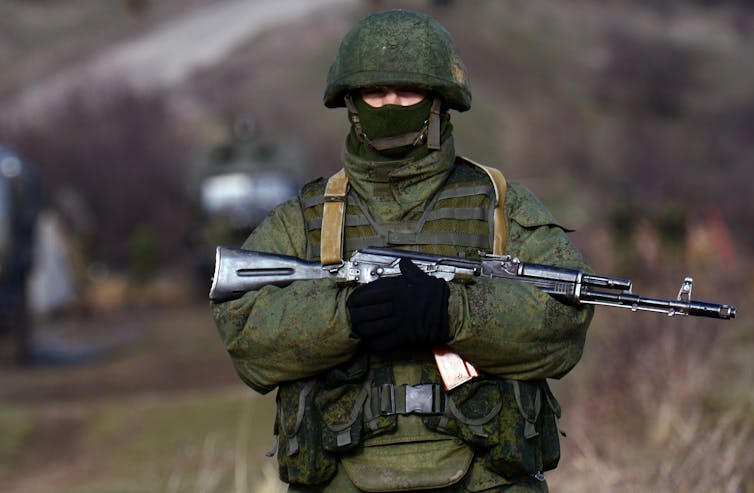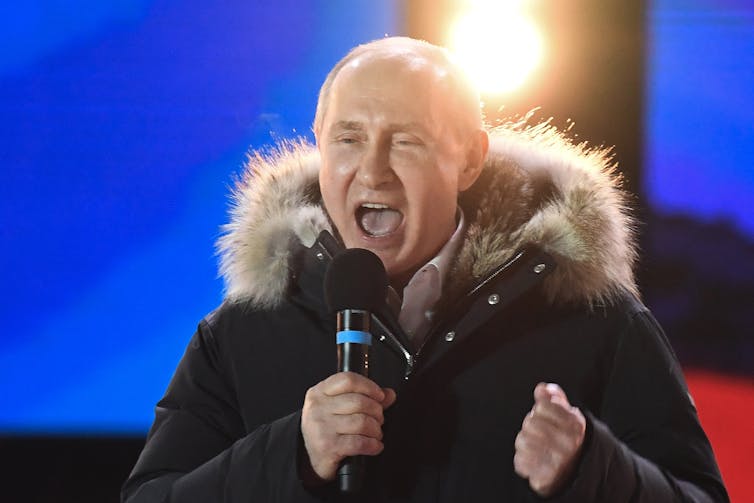
Russia’s illegal annexation of Ukraine’s Crimean Peninsula in 2014 was the first change of internationally recognized borders in Europe through military force since World War II.
Russia proceeded to instigate and fuel a war in eastern Ukraine that has claimed some 14,000 lives so far. Last year, Russia began massing a force of more than 100,000 troops along Ukraine’s eastern and northern border and in the occupied Crimea, and taking other provocative actions. U.S. President Joe Biden said on Jan. 19, 2022, about Putin: “Do I think he’ll test the West, test the United States and NATO, as significantly as he can? Yes, I think he will.”
Ukraine as an independent state was born from the 1991 collapse of the Soviet Union. Its independence came with a complicated Cold War inheritance: the world’s third-largest stockpile of nuclear weapons. Ukraine was one of the three non-Russian former Soviet states, including Belarus and Kazakhstan, that emerged from the Soviet collapse with nuclear weapons on its territory.
The U.S., in a burst of diplomatic energy and at a time of unmatched global influence, worked to prevent the unprecedented collapse of a nuclear superpower from leading to history’s largest proliferation of nuclear weapons.
This diplomatic activity manifested in security assurances for Ukraine embedded in what has become known as the Budapest Memorandum. With the entrance of Ukraine into the international order as a non-nuclear state, Russia, the U.S. and the U.K. pledged to “respect the independence and sovereignty and the existing borders of Ukraine.” The memo reaffirmed their obligation to “refrain from the threat or use of force against the territorial integrity or political independence of Ukraine.” The signatories also reaffirmed their commitment to “seek immediate” UN Security Council action “to provide assistance to Ukraine … if Ukraine should become a victim of an act of aggression.” These assurances upheld obligations contained in the U.N. charter and the 1975 Helsinki Final Act.
Ukraine, in turn, gave up the nuclear weapons within its borders, sending them to Russia for dismantling.
In light of Russia’s annexation of Crimea and its current threat to Ukrainian sovereignty, it’s fair to ask: What is the significance now of the Budapest Memorandum?

Ukrainian regrets
The memorandum, signed in 1994, is not legally binding.
Nonetheless, it embeds and reaffirms the solemn assurances that are the hallmark of the international system. These include respect for state sovereignty, the inviolability of international borders and abstention from the threat or use of force.
Ukraine’s decision to give up nuclear weapons signaled its desire to be seen as a member in good standing of the international community, rather than an outlier.
The decision was not just symbolic. While Ukraine did not inherit a fully fledged nuclear capacity – Russia still held important parts of the nuclear infrastructure – Ukraine had the necessary technological and industrial ability to close the gaps.
Many in Ukraine feel that the country’s 1994 decision to give up its nuclear arms was a mistake.
Popular support for nuclear rearmament rose to a historic high of nearly 50% in the wake of Russia’s invasion in 2014. Since then, that view has been supported by some Ukrainian public figures.

‘No changing of borders by use of force’
Russia has blatantly violated the Budapest Memorandum. And the initial response to the annexation of Crimea by the other signatories, the U.S. and U.K., was hesitant and restrained.
The U.S. has committed more than US$2.5 billion in military assistance since 2014 to Ukraine, including lethal defensive arms. Legislation pending in Congress would increase military aid. The Biden administration has also threatened severe economic sanctions in the event of Russian aggression, backed by sustained efforts to build support among allies. The adminstration’s resolute approach is consistent with the security assurances of the Budapest Memorandum.
We are both foreign policy scholars; one of us is a former U.S. ambassador to Poland. The strong defense of the fundamental principle of the international system – no changing of borders by use of force – has consequence for all of Europe, for U.S.-Russia relations and for other potential flash points, including China and Taiwan.
Whether the strong actions – such as the promise of military support for Ukraine and the threat of sanctions on Russia, backed by diplomacy by the United States and its allies – will be enough to deter Russia is uncertain and, many say, unlikely.
The size and scope of Russian military buildup are deeply troubling: Shifting 100,000 troops across Russia’s vast territory is a costly operation. The Kremlin is unlikely to pull back that kind of force without any diplomatic or military wins, such as closing the door to Ukraine’s future membership in NATO, which the United States has ruled out.
International law matters, but it does not determine what states do. Strong deterrence, diplomacy and international solidarity can influence Russian decision-making. The U.S. is also actively working with Ukraine, an essential element to a successful diplomatic and deterrence strategy.
Ultimately, however, the de-escalation decision is Russia’s to make. The role of the U.S., its NATO allies, and Ukraine is to make sure the consequences of Russia’s decisions are clear to the Kremlin and that they can be carried out with strong and united Western backing in the event Russia chooses the path of war.
The authors do not work for, consult, own shares in or receive funding from any company or organization that would benefit from this article, and have disclosed no relevant affiliations beyond their academic appointment.
This article was originally published on The Conversation. Read the original article.







